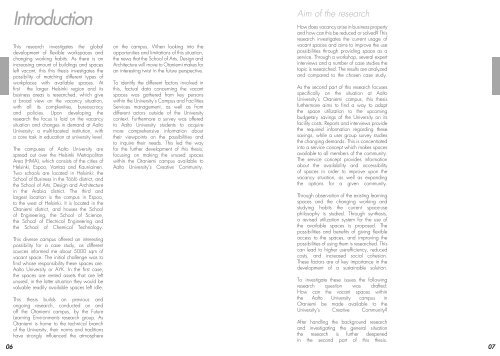View/Open - Aaltodoc
View/Open - Aaltodoc
View/Open - Aaltodoc
You also want an ePaper? Increase the reach of your titles
YUMPU automatically turns print PDFs into web optimized ePapers that Google loves.
06<br />
Introduction<br />
This research investigates the global<br />
development of flexible workspaces and<br />
changing working habits. As there is an<br />
increasing amount of buildings and spaces<br />
left vacant, this this thesis investigates the<br />
possibility of matching different types of<br />
workplaces with available spaces. At<br />
first the larger Helsinki region and its<br />
business areas is researched, which give<br />
a broad view on the vacancy situation,<br />
with all its complexities, bureaucracy<br />
and policies. Upon developing the<br />
research the focus is laid on the vacancy<br />
situation and changes in demand at Aalto<br />
University: a multi-faceted institution, with<br />
a core task in education at university level.<br />
The campuses of Aalto University are<br />
spread out over the Helsinki Metropolitan<br />
Area (HMA), which consists of the cities of<br />
Helsinki, Espoo, Vantaa and Kauniainen.<br />
Two schools are located in Helsinki: the<br />
School of Business in the Töölö district, and<br />
the School of Arts, Design and Architecture<br />
in the Arabia district. The third and<br />
largest location is the campus in Espoo,<br />
to the west of Helsinki. It is located in the<br />
Otaniemi district, and houses the School<br />
of Engineering, the School of Science,<br />
the School of Electrical Engineering and<br />
the School of Chemical Technology.<br />
This diverse campus offered an interesting<br />
possibility for a case study, as different<br />
sources informed me about 5000 sqm of<br />
vacant space. The initial challenge was to<br />
find whose responsibility these spaces are:<br />
Aalto University or AYK. In the first case,<br />
the spaces are rented assets that are left<br />
unused, in the latter situation they would be<br />
valuable readily available spaces left idle.<br />
This thesis builds on previous and<br />
ongoing research, conducted on and<br />
off the Otaniemi campus, by the Future<br />
Learning Environments research group. As<br />
Otaniemi is home to the technical branch<br />
of the University, their norms and traditions<br />
have strongly influenced the atmosphere<br />
on the campus. When looking into the<br />
opportunities and limitations of this situation,<br />
the news that the School of Arts, Design and<br />
Architecture will move to Otaniemi makes for<br />
an interesting twist in the future perspective.<br />
To identify the different factors involved in<br />
this, factual data concerning the vacant<br />
spaces was gathered from key persons<br />
within the University’s Campus and Facilities<br />
Services management, as well as from<br />
different actors outside of the University<br />
context. Furthermore a survey was offered<br />
to Aalto University students to acquire<br />
more comprehensive information about<br />
their viewpoints on the possibilities and<br />
to inquire their needs. This led the way<br />
for the further development of this thesis,<br />
focusing on making the unused spaces<br />
within the Otaniemi campus available to<br />
Aalto University’s Creative Community.<br />
Aim of the research<br />
How does vacancy arise in business property<br />
and how can this be reduced or solved? This<br />
research investigates the current usage of<br />
vacant spaces and aims to improve the use<br />
possibilities through providing space as a<br />
service. Through a workshop, several expert<br />
interviews and a number of case studies the<br />
topic is researched. The results are analyzed<br />
and compared to the chosen case study.<br />
As the second part of this research focuses<br />
specifically on the situation at Aalto<br />
University’s Otaniemi campus, this thesis<br />
furthermore aims to find a way to adapt<br />
the space utilization to the upcoming<br />
budgetary savings of the University on its<br />
facility costs. Reports and interviews provide<br />
the required information regarding these<br />
savings, while a user group survey studies<br />
the changing demands. This is concentrated<br />
into a service concept which makes spaces<br />
available to all members of the community.<br />
The service concept provides information<br />
about the availability and accessibility<br />
of spaces in order to improve upon the<br />
vacancy situation, as well as expanding<br />
the options for a given community.<br />
Through observation of the existing learning<br />
spaces and the changing working and<br />
studying habits the current space-use<br />
philosophy is studied. Through synthesis,<br />
a revised utilization system for the use of<br />
the available spaces is proposed. The<br />
possibilities and benefits of giving flexible<br />
access to the spaces, and improving the<br />
possibilities of using them is researched. This<br />
can lead to higher use-efficiency, reduced<br />
costs, and increased social cohesion.<br />
These factors are of key importance in the<br />
development of a sustainable solution.<br />
To investigate these issues the following<br />
research question was drafted:<br />
How can the vacant spaces within<br />
the Aalto University campus in<br />
Otaniemi be made available to the<br />
University’s Creative Community?<br />
After handling the background research<br />
and investigating the general situation<br />
the research is further deepened<br />
in the second part of this thesis.<br />
07
















